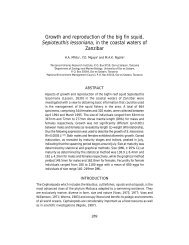gpa_east_africa_case.. - GRID Africa GeoPortal - UNEP
gpa_east_africa_case.. - GRID Africa GeoPortal - UNEP
gpa_east_africa_case.. - GRID Africa GeoPortal - UNEP
Create successful ePaper yourself
Turn your PDF publications into a flip-book with our unique Google optimized e-Paper software.
Characteristics of Cost – Benefit AnalysisCBA is a powerful and versatile tool that enables economists and planners to construct aninformation and evaluation framework for the appraisal of planned or on-going investments.The main characteristic of CBA is its capability to go beyond financial analysis and profitabilityconcerns, from the point of view of the sponsoring agency, and take into account a widerdefinition of costs and benefits more appropriate for the analysis of environmental and publicutility projects. Since most of the results or outputs of environmental projects are not traded inmarkets for goods and services financial costs and revenues fail to capture thesocial/community benefits associated with environmental improvements. On the basis offinancial criteria environmental investment may fail to prove viable and fail to secure publicfunds. The methodology for comparing costs and benefits is similar whether we are seekingthe economic or financial benefits of investments. What is defined as a cost and what isdefined a benefit is different.Methodology for the Use of Cost-Benefit Analysis in Environmental Projects, G.Constantinides, <strong>UNEP</strong>(OCA)/MED WG. 45/5, 1992The application of Cost-Benefit Analysis and the use of associated estimation andmeasurement tools, in addition to the technical economic analysis they bring to bear onproject evaluation, help build up awareness of the economic importance of coastal ecologyand create a shared basis for converging responses among different stakeholders. Thisfacilitates the gradual move towards consensus on environmental priorities seen as partthe process of social and economic development and community well-being, rather than assectoral policy concerns of limited direct importance to society at large. The application ofCost-Benefit Analysis and its focus on the links between ecological damage from pollutionand its socio-economic costs, foster a broader framework for improving participationpractices and partnerships that support a common perception of the social consequencesof pollution and areas of agreement on appropriate responses.The contribution of Cost-Benefit Analysis to consensus-building arises from the fact thatenvironmental impacts on the quality of the coastal and marine environment translate intosocio-economic losses due to resource productivity changes, loss of income, health effectsand cumulative impacts on living conditions, poverty and economic development. While theoccurrence of pollution is a subject of scientific activity, the effects of pollution translated inCost-Benefit terms highlight a much broader area of concern about human and economicconditions with cross-cutting community and development affects. The productivity of coastalagriculture, tourism, fisheries and the state of public health are highly dependent on thequality of coastal and marine resources and a major sources of livelihood for the majority ofthe coastal population. The links between pollution and social responses are central to Cost-Benefit Analysis. In short, Cost-benefit Analysis creates a clearer understanding of the factthat solving wastewater pollution problems solves development problems.1.6 Wastewater problems and Cost-Benefit AnalysisUncontrolled wastewater disposal generates human and economic costs through impacts onthree main spheres that inter-mediate between the environment and economic factors:• Living conditions in settlements;• Environmental conditions of rivers and lakes near cities; and• Production conditions of coastal and marine lifeThese three spheres of environmental impacts are clearly identified in the GPA DraftRecommendations for Decision Making on Municipal Wastewater, Chapter 1 "ManagingMunicipal Wastewater: a growing challenge").• Impacts on the living environment. Domestic wastewater is generated by populationactivity in a neighbourhood context with houses, shops, small factories, etc. Sewageaccumulation in settlements poses a serious health risk to the population leading to thespread of diseases, mortality, morbidity, increased public and private medical costs andFinal Draft Report – Cost Benefit Case StudiesGPA Strategic Action Plan on Sewage, October, 200013



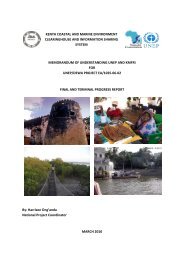

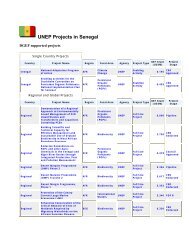


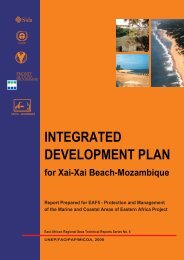

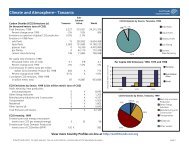

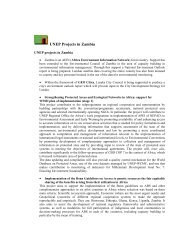
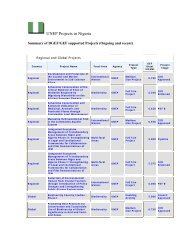
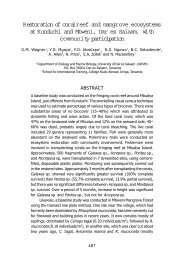
![Please Click to download [English] - GRID Africa GeoPortal - UNEP](https://img.yumpu.com/30633391/1/184x260/please-click-to-download-english-grid-africa-geoportal-unep.jpg?quality=85)
